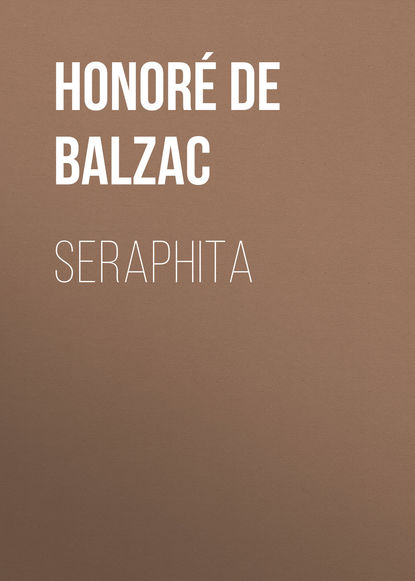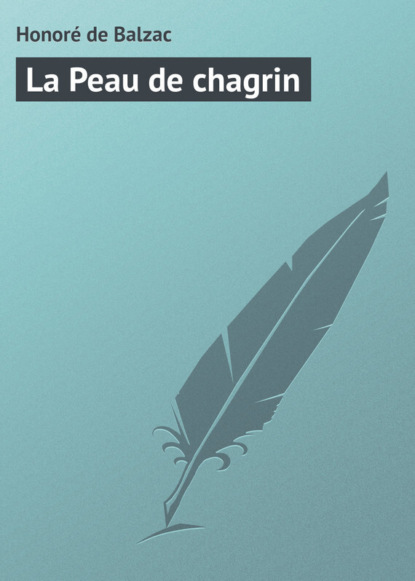
Полная версия
Seraphita

Honoré de Balzac
Seraphita
To Madame Eveline de Hanska, nee Comtesse Rzewuska.
Madame, – Here is the work which you asked of me. I am happy, in thus dedicating it, to offer you a proof of the respectful affection you allow me to bear you. If I am reproached for impotence in this attempt to draw from the depths of mysticism a book which seeks to give, in the lucid transparency of our beautiful language, the luminous poesy of the Orient, to you the blame! Did you not command this struggle (resembling that of Jacob) by telling me that the most imperfect sketch of this Figure, dreamed of by you, as it has been by me since childhood, would still be something to you?
Here, then, it is, – that something. Would that this book could belong exclusively to noble spirits, preserved like yours from worldly pettiness by solitude! THEY would know how to give to it the melodious rhythm that it lacks, which might have made it, in the hands of a poet, the glorious epic that France still awaits. But from me they must accept it as one of those sculptured balustrades, carved by a hand of faith, on which the pilgrims lean, in the choir of some glorious church, to think upon the end of man.
I am, madame, with respect,
Your devoted servant,
De Balzac.
CHAPTER I. SERAPHITUS
As the eye glances over a map of the coasts of Norway, can the imagination fail to marvel at their fantastic indentations and serrated edges, like a granite lace, against which the surges of the North Sea roar incessantly? Who has not dreamed of the majestic sights to be seen on those beachless shores, of that multitude of creeks and inlets and little bays, no two of them alike, yet all trackless abysses? We may almost fancy that Nature took pleasure in recording by ineffaceable hieroglyphics the symbol of Norwegian life, bestowing on these coasts the conformation of a fish’s spine, fishery being the staple commerce of the country, and well-nigh the only means of living of the hardy men who cling like tufts of lichen to the arid cliffs. Here, through fourteen degrees of longitude, barely seven hundred thousand souls maintain existence. Thanks to perils devoid of glory, to year-long snows which clothe the Norway peaks and guard them from profaning foot of traveller, these sublime beauties are virgin still; they will be seen to harmonize with human phenomena, also virgin – at least to poetry – which here took place, the history of which it is our purpose to relate.
If one of these inlets, mere fissures to the eyes of the eider-ducks, is wide enough for the sea not to freeze between the prison-walls of rock against which it surges, the country-people call the little bay a “fiord,” – a word which geographers of every nation have adopted into their respective languages. Though a certain resemblance exists among all these fiords, each has its own characteristics. The sea has everywhere forced its way as through a breach, yet the rocks about each fissure are diversely rent, and their tumultuous precipices defy the rules of geometric law. Here the scarp is dentelled like a saw; there the narrow ledges barely allow the snow to lodge or the noble crests of the Northern pines to spread themselves; farther on, some convulsion of Nature may have rounded a coquettish curve into a lovely valley flanked in rising terraces with black-plumed pines. Truly we are tempted to call this land the Switzerland of Ocean.
Midway between Trondhjem and Christiansand lies an inlet called the Strom-fiord. If the Strom-fiord is not the loveliest of these rocky landscapes, it has the merit of displaying the terrestrial grandeurs of Norway, and of enshrining the scenes of a history that is indeed celestial.
The general outline of the Strom-fiord seems at first sight to be that of a funnel washed out by the sea. The passage which the waves have forced present to the eye an image of the eternal struggle between old Ocean and the granite rock, – two creations of equal power, one through inertia, the other by ceaseless motion. Reefs of fantastic shape run out on either side, and bar the way of ships and forbid their entrance. The intrepid sons of Norway cross these reefs on foot, springing from rock to rock, undismayed at the abyss – a hundred fathoms deep and only six feet wide – which yawns beneath them. Here a tottering block of gneiss falling athwart two rocks gives an uncertain footway; there the hunters or the fishermen, carrying their loads, have flung the stems of fir-trees in guise of bridges, to join the projecting reefs, around and beneath which the surges roar incessantly. This dangerous entrance to the little bay bears obliquely to the right with a serpentine movement, and there encounters a mountain rising some twenty-five hundred feet above sea-level, the base of which is a vertical palisade of solid rock more than a mile and a half long, the inflexible granite nowhere yielding to clefts or undulations until it reaches a height of two hundred feet above the water. Rushing violently in, the sea is driven back with equal violence by the inert force of the mountain to the opposite shore, gently curved by the spent force of the retreating waves.
The fiord is closed at the upper end by a vast gneiss formation crowned with forests, down which a river plunges in cascades, becomes a torrent when the snows are melting, spreads into a sheet of waters, and then falls with a roar into the bay, – vomiting as it does so the hoary pines and the aged larches washed down from the forests and scarce seen amid the foam. These trees plunge headlong into the fiord and reappear after a time on the surface, clinging together and forming islets which float ashore on the beaches, where the inhabitants of a village on the left bank of the Strom-fiord gather them up, split, broken (though sometimes whole), and always stripped of bark and branches. The mountain which receives at its base the assaults of Ocean, and at its summit the buffeting of the wild North wind, is called the Falberg. Its crest, wrapped at all seasons in a mantle of snow and ice, is the sharpest peak of Norway; its proximity to the pole produces, at the height of eighteen hundred feet, a degree of cold equal to that of the highest mountains of the globe. The summit of this rocky mass, rising sheer from the fiord on one side, slopes gradually downward to the east, where it joins the declivities of the Sieg and forms a series of terraced valleys, the chilly temperature of which allows no growth but that of shrubs and stunted trees.
The upper end of the fiord, where the waters enter it as they come down from the forest, is called the Siegdahlen, – a word which may be held to mean “the shedding of the Sieg,” – the river itself receiving that name. The curving shore opposite to the face of the Falberg is the valley of Jarvis, – a smiling scene overlooked by hills clothed with firs, birch-trees, and larches, mingled with a few oaks and beeches, the richest coloring of all the varied tapestries which Nature in these northern regions spreads upon the surface of her rugged rocks. The eye can readily mark the line where the soil, warmed by the rays of the sun, bears cultivation and shows the native growth of the Norwegian flora. Here the expanse of the fiord is broad enough to allow the sea, dashed back by the Falberg, to spend its expiring force in gentle murmurs upon the lower slope of these hills, – a shore bordered with finest sand, strewn with mica and sparkling pebbles, porphyry, and marbles of a thousand tints, brought from Sweden by the river floods, together with ocean waifs, shells, and flowers of the sea driven in by tempests, whether of the Pole or Tropics.
At the foot of the hills of Jarvis lies a village of some two hundred wooden houses, where an isolated population lives like a swarm of bees in a forest, without increasing or diminishing; vegetating happily, while wringing their means of living from the breast of a stern Nature. The almost unknown existence of the little hamlet is readily accounted for. Few of its inhabitants were bold enough to risk their lives among the reefs to reach the deep-sea fishing, – the staple industry of Norwegians on the least dangerous portions of their coast. The fish of the fiord were numerous enough to suffice, in part at least, for the sustenance of the inhabitants; the valley pastures provided milk and butter; a certain amount of fruitful, well-tilled soil yielded rye and hemp and vegetables, which necessity taught the people to protect against the severity of the cold and the fleeting but terrible heat of the sun with the shrewd ability which Norwegians display in the two-fold struggle. The difficulty of communication with the outer world, either by land where the roads are impassable, or by sea where none but tiny boats can thread their way through the maritime defiles that guard the entrance to the bay, hinder these people from growing rich by the sale of their timber. It would cost enormous sums to either blast a channel out to sea or construct a way to the interior. The roads from Christiana to Trondhjem all turn toward the Strom-fiord, and cross the Sieg by a bridge some score of miles above its fall into the bay. The country to the north, between Jarvis and Trondhjem, is covered with impenetrable forests, while to the south the Falberg is nearly as much separated from Christiana by inaccessible precipices. The village of Jarvis might perhaps have communicated with the interior of Norway and Sweden by the river Sieg; but to do this and to be thus brought into contact with civilization, the Strom-fiord needed the presence of a man of genius. Such a man did actually appear there, – a poet, a Swede of great religious fervor, who died admiring, even reverencing this region as one of the noblest works of the Creator.
Minds endowed by study with an inward sight, and whose quick perceptions bring before the soul, as though painted on a canvas, the contrasting scenery of this universe, will now apprehend the general features of the Strom-fiord. They alone, perhaps, can thread their way through the tortuous channels of the reef, or flee with the battling waves to the everlasting rebuff of the Falberg whose white peaks mingle with the vaporous clouds of the pearl-gray sky, or watch with delight the curving sheet of waters, or hear the rushing of the Sieg as it hangs for an instant in long fillets and then falls over a picturesque abatis of noble trees toppled confusedly together, sometimes upright, sometimes half-sunken beneath the rocks. It may be that such minds alone can dwell upon the smiling scenes nestling among the lower hills of Jarvis; where the luscious Northern vegetables spring up in families, in myriads, where the white birches bend, graceful as maidens, where colonnades of beeches rear their boles mossy with the growth of centuries, where shades of green contrast, and white clouds float amid the blackness of the distant pines, and tracts of many-tinted crimson and purple shrubs are shaded endlessly; in short, where blend all colors, all perfumes of a flora whose wonders are still ignored. Widen the boundaries of this limited ampitheatre, spring upward to the clouds, lose yourself among the rocks where the seals are lying and even then your thought cannot compass the wealth of beauty nor the poetry of this Norwegian coast. Can your thought be as vast as the ocean that bounds it? as weird as the fantastic forms drawn by these forests, these clouds, these shadows, these changeful lights?
Do you see above the meadows on that lowest slope which undulates around the higher hills of Jarvis two or three hundred houses roofed with “noever,” a sort of thatch made of birch-bark, – frail houses, long and low, looking like silk-worms on a mulberry-leaf tossed hither by the winds? Above these humble, peaceful dwellings stands the church, built with a simplicity in keeping with the poverty of the villagers. A graveyard surrounds the chancel, and a little farther on you see the parsonage. Higher up, on a projection of the mountain is a dwelling-house, the only one of stone; for which reason the inhabitants of the village call it “the Swedish Castle.” In fact, a wealthy Swede settled in Jarvis about thirty years before this history begins, and did his best to ameliorate its condition. This little house, certainly not a castle, built with the intention of leading the inhabitants to build others like it, was noticeable for its solidity and for the wall that inclosed it, a rare thing in Norway where, notwithstanding the abundance of stone, wood alone is used for all fences, even those of fields. This Swedish house, thus protected against the climate, stood on rising ground in the centre of an immense courtyard. The windows were sheltered by those projecting pent-house roofs supported by squared trunks of trees which give so patriarchal an air to Northern dwellings. From beneath them the eye could see the savage nudity of the Falberg, or compare the infinitude of the open sea with the tiny drop of water in the foaming fiord; the ear could hear the flowing of the Sieg, whose white sheet far away looked motionless as it fell into its granite cup edged for miles around with glaciers, – in short, from this vantage ground the whole landscape whereon our simple yet superhuman drama was about to be enacted could be seen and noted.
The winter of 1799-1800 was one of the most severe ever known to Europeans. The Norwegian sea was frozen in all the fiords, where, as a usual thing, the violence of the surf kept the ice from forming. A wind, whose effects were like those of the Spanish levanter, swept the ice of the Strom-fiord, driving the snow to the upper end of the gulf. Seldom indeed could the people of Jarvis see the mirror of frozen waters reflecting the colors of the sky; a wondrous site in the bosom of these mountains when all other aspects of nature are levelled beneath successive sheets of snow, and crests and valleys are alike mere folds of the vast mantle flung by winter across a landscape at once so mournfully dazzling and so monotonous. The falling volume of the Sieg, suddenly frozen, formed an immense arcade beneath which the inhabitants might have crossed under shelter from the blast had any dared to risk themselves inland. But the dangers of every step away from their own surroundings kept even the boldest hunters in their homes, afraid lest the narrow paths along the precipices, the clefts and fissures among the rocks, might be unrecognizable beneath the snow.
Thus it was that no human creature gave life to the white desert where Boreas reigned, his voice alone resounding at distant intervals. The sky, nearly always gray, gave tones of polished steel to the ice of the fiord. Perchance some ancient eider-duck crossed the expanse, trusting to the warm down beneath which dream, in other lands, the luxurious rich, little knowing of the dangers through which their luxury has come to them. Like the Bedouin of the desert who darts alone across the sands of Africa, the bird is neither seen nor heard; the torpid atmosphere, deprived of its electrical conditions, echoes neither the whirr of its wings nor its joyous notes. Besides, what human eye was strong enough to bear the glitter of those pinnacles adorned with sparkling crystals, or the sharp reflections of the snow, iridescent on the summits in the rays of a pallid sun which infrequently appeared, like a dying man seeking to make known that he still lives. Often, when the flocks of gray clouds, driven in squadrons athwart the mountains and among the tree-tops, hid the sky with their triple veils Earth, lacking the celestial lights, lit herself by herself.
Here, then, we meet the majesty of Cold, seated eternally at the pole in that regal silence which is the attribute of all absolute monarchy. Every extreme principle carries with it an appearance of negation and the symptoms of death; for is not life the struggle of two forces? Here in this Northern nature nothing lived. One sole power – the unproductive power of ice – reigned unchallenged. The roar of the open sea no longer reached the deaf, dumb inlet, where during one short season of the year Nature made haste to produce the slender harvests necessary for the food of the patient people. A few tall pine-trees lifted their black pyramids garlanded with snow, and the form of their long branches and depending shoots completed the mourning garments of those solemn heights.
Each household gathered in its chimney-corner, in houses carefully closed from the outer air, and well supplied with biscuit, melted butter, dried fish, and other provisions laid in for the seven-months winter. The very smoke of these dwellings was hardly seen, half-hidden as they were beneath the snow, against the weight of which they were protected by long planks reaching from the roof and fastened at some distance to solid blocks on the ground, forming a covered way around each building.
During these terrible winter months the women spun and dyed the woollen stuffs and the linen fabrics with which they clothed their families, while the men read, or fell into those endless meditations which have given birth to so many profound theories, to the mystic dreams of the North, to its beliefs, to its studies (so full and so complete in one science, at least, sounded as with a plummet), to its manners and its morals, half-monastic, which force the soul to react and feed upon itself and make the Norwegian peasant a being apart among the peoples of Europe.
Such was the condition of the Strom-fiord in the first year of the nineteenth century and about the middle of the month of May.
On a morning when the sun burst forth upon this landscape, lighting the fires of the ephemeral diamonds produced by crystallizations of the snow and ice, two beings crossed the fiord and flew along the base of the Falberg, rising thence from ledge to ledge toward the summit. What were they? human creatures, or two arrows? They might have been taken for eider-ducks sailing in consort before the wind. Not the boldest hunter nor the most superstitious fisherman would have attributed to human beings the power to move safely along the slender lines traced beneath the snow by the granite ledges, where yet this couple glided with the terrifying dexterity of somnambulists who, forgetting their own weight and the dangers of the slightest deviation, hurry along a ridge-pole and keep their equilibrium by the power of some mysterious force.
“Stop me, Seraphitus,” said a pale young girl, “and let me breathe. I look at you, you only, while scaling these walls of the gulf; otherwise, what would become of me? I am such a feeble creature. Do I tire you?”
“No,” said the being on whose arm she leaned. “But let us go on, Minna; the place where we are is not firm enough to stand on.”
Once more the snow creaked sharply beneath the long boards fastened to their feet, and soon they reached the upper terrace of the first ledge, clearly defined upon the flank of the precipice. The person whom Minna had addressed as Seraphitus threw his weight upon his right heel, arresting the plank – six and a half feet long and narrow as the foot of a child – which was fastened to his boot by a double thong of leather. This plank, two inches thick, was covered with reindeer skin, which bristled against the snow when the foot was raised, and served to stop the wearer. Seraphitus drew in his left foot, furnished with another “skee,” which was only two feet long, turned swiftly where he stood, caught his timid companion in his arms, lifted her in spite of the long boards on her feet, and placed her on a projecting rock from which he brushed the snow with his pelisse.
“You are safe there, Minna; you can tremble at your ease.”
“We are a third of the way up the Ice-Cap,” she said, looking at the peak to which she gave the popular name by which it is known in Norway; “I can hardly believe it.”
Too much out of breath to say more, she smiled at Seraphitus, who, without answering, laid his hand upon her heart and listened to its sounding throbs, rapid as those of a frightened bird.
“It often beats as fast when I run,” she said.
Seraphitus inclined his head with a gesture that was neither coldness nor indifference, and yet, despite the grace which made the movement almost tender, it none the less bespoke a certain negation, which in a woman would have seemed an exquisite coquetry. Seraphitus clasped the young girl in his arms. Minna accepted the caress as an answer to her words, continuing to gaze at him. As he raised his head, and threw back with impatient gesture the golden masses of his hair to free his brow, he saw an expression of joy in the eyes of his companion.
“Yes, Minna,” he said in a voice whose paternal accents were charming from the lips of a being who was still adolescent, “Keep your eyes on me; do not look below you.”
“Why not?” she asked.
“You wish to know why? then look!”
Minna glanced quickly at her feet and cried out suddenly like a child who sees a tiger. The awful sensation of abysses seized her; one glance sufficed to communicate its contagion. The fiord, eager for food, bewildered her with its loud voice ringing in her ears, interposing between herself and life as though to devour her more surely. From the crown of her head to her feet and along her spine an icy shudder ran; then suddenly intolerable heat suffused her nerves, beat in her veins and overpowered her extremities with electric shocks like those of the torpedo. Too feeble to resist, she felt herself drawn by a mysterious power to the depths below, wherein she fancied that she saw some monster belching its venom, a monster whose magnetic eyes were charming her, whose open jaws appeared to craunch their prey before they seized it.
“I die, my Seraphitus, loving none but thee,” she said, making a mechanical movement to fling herself into the abyss.
Seraphitus breathed softly on her forehead and eyes. Suddenly, like a traveller relaxed after a bath, Minna forgot these keen emotions, already dissipated by that caressing breath which penetrated her body and filled it with balsamic essences as quickly as the breath itself had crossed the air.
“Who art thou?” she said, with a feeling of gentle terror. “Ah, but I know! thou art my life. How canst thou look into that gulf and not die?” she added presently.
Seraphitus left her clinging to the granite rock and placed himself at the edge of the narrow platform on which they stood, whence his eyes plunged to the depths of the fiord, defying its dazzling invitation. His body did not tremble, his brow was white and calm as that of a marble statue, – an abyss facing an abyss.
“Seraphitus! dost thou not love me? come back!” she cried. “Thy danger renews my terror. Who art thou to have such superhuman power at thy age?” she asked as she felt his arms inclosing her once more.
“But, Minna,” answered Seraphitus, “you look fearlessly at greater spaces far than that.”
Then with raised finger, this strange being pointed upward to the blue dome, which parting clouds left clear above their heads, where stars could be seen in open day by virtue of atmospheric laws as yet unstudied.
“But what a difference!” she answered smiling.
“You are right,” he said; “we are born to stretch upward to the skies. Our native land, like the face of a mother, cannot terrify her children.”
His voice vibrated through the being of his companion, who made no reply.
“Come! let us go on,” he said.
The pair darted forward along the narrow paths traced back and forth upon the mountain, skimming from terrace to terrace, from line to line, with the rapidity of a barb, that bird of the desert. Presently they reached an open space, carpeted with turf and moss and flowers, where no foot had ever trod.
“Oh, the pretty saeter!” cried Minna, giving to the upland meadow its Norwegian name. “But how comes it here, at such a height?”
“Vegetation ceases here, it is true,” said Seraphitus. “These few plants and flowers are due to that sheltering rock which protects the meadow from the polar winds. Put that tuft in your bosom, Minna,” he added, gathering a flower, – “that balmy creation which no eye has ever seen; keep the solitary matchless flower in memory of this one matchless morning of your life. You will find no other guide to lead you again to this saeter.”
So saying, he gave her the hybrid plant his falcon eye had seen amid the tufts of gentian acaulis and saxifrages, – a marvel, brought to bloom by the breath of angels. With girlish eagerness Minna seized the tufted plant of transparent green, vivid as emerald, which was formed of little leaves rolled trumpet-wise, brown at the smaller end but changing tint by tint to their delicately notched edges, which were green. These leaves were so tightly pressed together that they seemed to blend and form a mat or cluster of rosettes. Here and there from this green ground rose pure white stars edged with a line of gold, and from their throats came crimson anthers but no pistils. A fragrance, blended of roses and of orange blossoms, yet ethereal and fugitive, gave something as it were celestial to that mysterious flower, which Seraphitus sadly contemplated, as though it uttered plaintive thoughts which he alone could understand. But to Minna this mysterious phenomenon seemed a mere caprice of nature giving to stone the freshness, softness, and perfume of plants.












